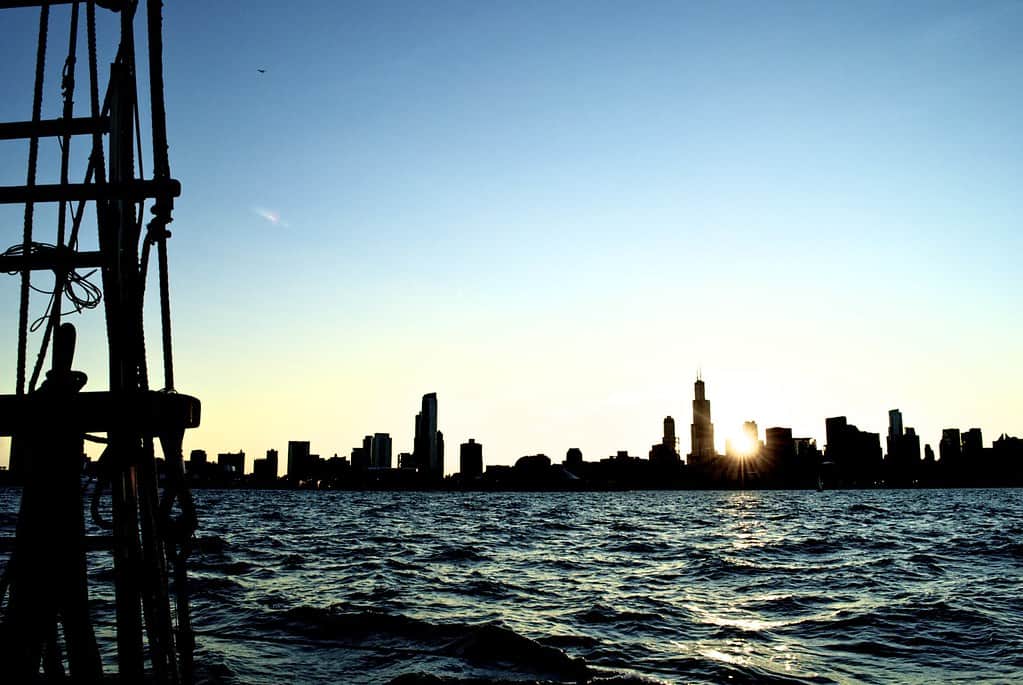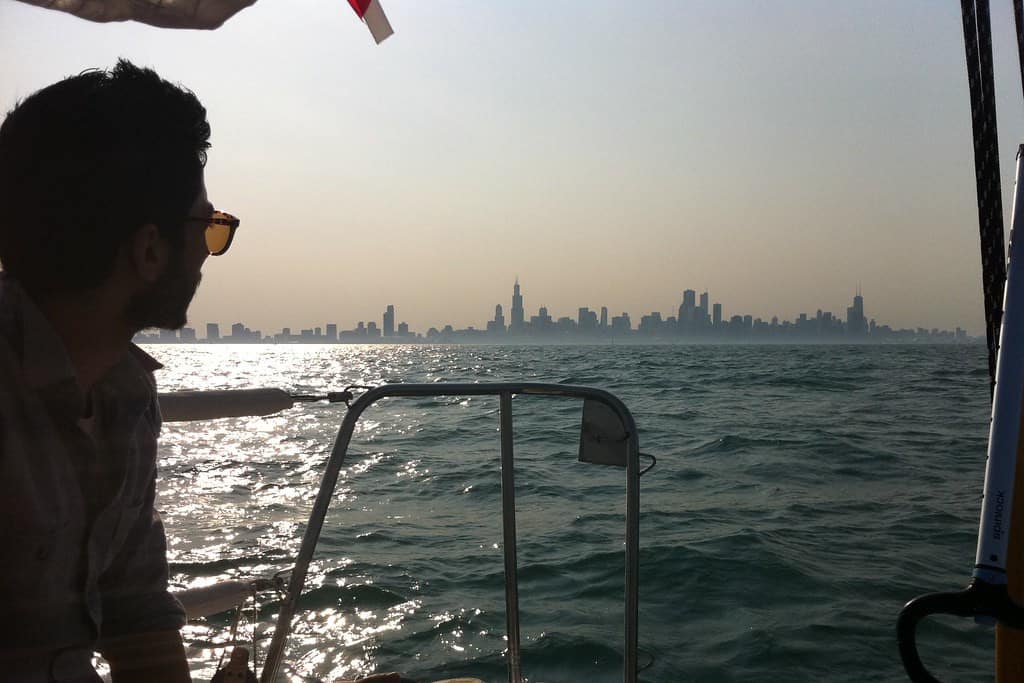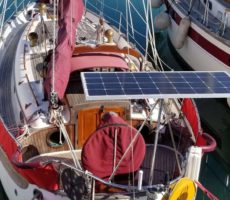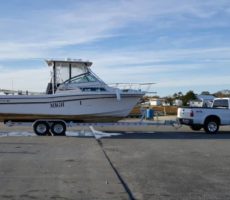Whether you’re looking to sail yourself or to join a group on a charter yacht, the Great Lakes are living up to their name as hot cruise destinations.
How Long Does It Take to Sail Across Lake Michigan? It takes about 5-8 hours for a sailboat to cross Lake Michigan from Chicago to New Buffalo, depending on your speed and whether you’re going offshore or along the coast. If you are sailing from Milwaukee to Muskegon which is 70 NM (80 mi, 130 km) it will take about 10-15 hours to cross in a sailboat at 6-8 knots.
For powerboats, it’s a lot faster, around 1-3 hours depending on where you cross the lake.
How long would it take to cross Lake Michigan?
With a length of 307 mi (494 km) and breadth of 118 mi (190km) Lake Michigan is a hot sailing destination and is attracting a lot of attention lately from cruise ship companies, but also from skippers looking to gain experience.
Sailing lake michigan and the Great Lakes, in general, is a good place for skippers to gain some blue water experience before sailing the Atlantic or sailing around the world. When crossing Lake Michigan you will usually encounter 10-20 knot winds (often even 20+) and 4-8 foot waves, sometimes higher.
It’s essential to factor in not just the direct distance across Lake Michigan but also the unpredictability of winds and currents when estimating your crossing time.
If you’re attempting a nonstop voyage, the quickest routes can shave off time, but always have a contingency plan since Lake Michigan can be unpredictable.
How Long to Cross Lake Michigan Along the Coast?
If you followed the coast from Chicago to New Buffalo, that’s a 70-80 mile trip and would take you about 8 hours to reach, depending on your speed.

Most people interested in sailing Lake Michigan want to go offshore and not follow the coast because it’s a different experience. In fact, the weather on Lake Michigan may change frequently and the experience changes every time you cross.
So, if you were to go from Chicago, IL to New Buffalo, MI that’s approximately 40 NM (nautical miles) (45 mi, 72 km) you would probably need about an hour on a motorboat directly across, provided you avoided the industrial shipping lanes around Gary, IN.
This also assumes good lake conditions, meaning no polar vortexes and only small waves, 1-4 feet.
Some Advice on Sailing Across Lake Michigan
There are some things you need to keep in mind when crossing Lake Michigan. First, the weather may change so frequently that you’ll experience something different on every crossing. This is true for sailing almost all of the Great Lakes.
What makes the lakes dangerous is the steep waves and strong gusts of winds. How long it will take you to cross Lake Michigan depends on both the weather and your speed.
Waves on Lake Michigan aren’t very high, as they are somewhat limited. Marine forecasters at the National Weather Service office in Romeoville say the highest waves on Lake Michigan were 20-23 feet in height. You usually want to go cross Lake Michigan when the waves are 1-2 feet.
If you’re looking to gain some blue water experience prior to sailing the oceans such as the Atlantic, you need to know that there’s a big difference between sailing the ocean and sailing across Lake Michigan.
10-foot waves in the middle of the ocean are usually large rollers, and aside from possibly getting seasick, you probably won’t get wet. 10-foot waves on the great lakes are nearly a survival situation.
The waves are steep, very close together, and often break. Not only will water be crashing over the boat, but also when combined with 40-knot winds, it may roll even a larger boat. Tighten your solar panels well, because these things may fly away easily.
If you’re sailing yourself across Lake Michigan or any of the Great Lakes, remember that this is a big body of water and subject to some extreme weather patterns, so you need to stay alert and be well prepared. If you don’t have much experience in freshwater, it’s useful to know that fresh water is less dense and can make for steeper waves, which can be much harder to “pound through.”
It may be smart to go across Lake Michigan when the waves are 1-2 feet and winds are less than 20 knots. When looking at forecasts, it is good to add additional 5 knots to the forecast to account for bursts of wind.
The sheer vastness of Lake Michigan, with its impressive breadth, can be deceptive; it’s essential to chart your exact route to understand the real distance you’ll be covering. The linear distance across Lake Michigan might seem straightforward, but with various crossing points and potential obstacles, it’s crucial to use navigation tools to get precise measurements.
Tools such as marine GPS systems, chartplotters, and even reliable mobile apps like Navionics can be instrumental for skippers navigating Lake Michigan. These devices not only provide accurate distance measurements but also real-time updates on water depths, marina locations, and potential hazards, ensuring a safer and more informed journey.
How to Sail Across the Lake Michigan by Myself?
Sailing Lake Michigan on a sailboat is a much different experience than sailing on a powerboat.
Sailing any of the Great Lakes requires you to keep your sailboat seaworthy, especially in challenging and dangerous waters such as Lake Michigan. How long to cross depends mostly on whether you plan to cross offshore or to sail along the coast.
It may not be a good idea to go looking for a cheap boat if you want to sail often. Consider costs, first. You would be surprised how much sails, motors, rigging, and fiberglass work costs. And how much work it is to do fix any of that.
You could start with something like a pocket cruiser, such as CAL 25. Make sure the boat you buy is in good shape, otherwise it will cost you a lot to keep it sailing.

A 27-30 footer is another option to cross Lake Michigan, rather than a trailer boat, especially if you don’t have much experience (and you do have money to buy). If you look at other types, non-trailer able boats like 27-30 ft., then you should know that it can get exponentially expensive the longer they are.
You could probably fly across on a Hobbie Cat in ideal conditions, but things can change unexpectedly offshore and you can get yourself in trouble fast. Plus, a little extra cabin space goes a long way when it comes to staying aboard for cruising.
So make sure your rigging, engine, and hull are always in good shape.
Good Choice for Boat When Sailing the Great Lakes
An asymmetric spinnaker may be a good choice to sail across Lake Michigan or any of the Great Lakes, It can, for example, help the boat speed up as the wind lightens on a broad or beam reach.
Asymmetric spinnakers look like a cross between a large jib and a spinnaker. They are usually larger than a conventional spinnaker with large sails that generate considerable power, but in many ways are easier to handle than a conventional spinnaker because the tack is attached to the end of the bowsprit, and they don’t require adjustments to a spinnaker pole.
With an asymmetric spinnaker, you will many times hold your speed at above 7 knots almost always while sailing across Lake Michigan, and you’ll reach the other side in no time. The spinnaker is excellent for sailing any of the Great Lakes.
If you were looking at a trailerable boat, a trailer-sailer, then you can get one relatively cheap, depending on what you’re looking for. Something like Marshall 22, Dana 24, Flicka 20 will get you there. Some are more seaworthy than others.
Some, like the Marshall 22, have a tabernacle mast, very little standing rigging, and shallow keel — which all make it easy to trailer and deploy.
The Flicka 20 and Falmouth Cutter 22 are very seaworthy – but have lots of standing rigging. And you’ll need a crane to take the mast off and put it on. That often costs more, plus getting all the rigging setup takes time. Generally speaking, the trailer requirement can really cut down your options.
The big caveat with having a smaller, trailerable boat is the weather. The overwhelming majority of trailerable boats less than 30ft will not handle 20+ knot winds and 6-9 foot waves well, which you will encounter at one point if you are cruising Lake Michigan. You could avoid weather by planning trips where you can stop for days at a time in marinas to wait for weather windows.
The Great Lakes are unpredictable and violent storms come up put off nowhere. Make sure you’re prepared and know some things about sailing these big lakes.
Consider going with someone who knows the waterways. Also, keep in mind that the great lakes are basically blue waters – if you run into trouble offshore you are basically on your own.








